Month: March, 2008
BSO’s Bolcom @ Carnegie Hall
Back in the second tier boxes for the third and final of the Boston Symphony Orchestra’s concerts at Carnegie Hall this season. The BSO’s current music director James Levine is dear to New Yorkers for his relationship with the Metropolitan Opera, where he has led the orchestra since 1971.
The program at Stern Auditorium was to include two works by Franz Schubert and the New York debut of William Bolcom‘s Eighth Symphony for Chorus and Orchestra on William Blake’s Prophetic Books. That piece, which was commissioned by Levine for the BSO’s 125th Anniversary, had its world premiere the week before, in Boston.
German bass-baritone Thomas Quastoff had been scheduled to perform a series of five songs by Schubert, but like SC, he was derailed by illness and could not appear. (In SC’s stead, JG valiantly stepped in to accompany me to this evening’s concert.) Quasthoff is most visibly recognizable for his physical disability; he has a full-size torso, but shortened, malformed arms and stands at just under four feet tall as a result of his mother’s Thalidomide use during pregnancy. (His life story has inspired a movie.) Quasthoff has won three Grammys for his Deutsche Grammophon recordings, and last month won a fourth with EMI Classics for “Best Choral Performance” in Brahms: “Ein Deutsches Requiem”, conducted by Simon Rattle.
So instead, we were presented with Brahms’s violin-less Serenade No. 2 after Schubert’s “Tragic” Symphony No. 4.
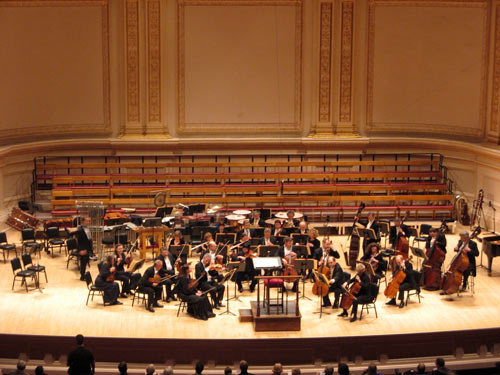
After intermission, the stage filled to near-overflowing for the Bolcom piece, which called for full strings and winds, extensive percussion and keyboards, and the Tanglewood Festival Chorus. (The Times and The Sun weigh in, positively.)
Bolcom’s best-known composition is another Blake inspiration, “Songs of Innocence and of Experience,” for which he won three 2006 Grammys, including “Best Classical Contemporary Composition.” The same year, the University of Michigan Professor of Composition was awarded the National Medal of Arts.
His Eighth Symphony began with a literal bang — jarring audience members in their seats — eventually settling into near musical rhythms. I was impressed that the chorus performed the whispering, wailing four-movement piece entirely from memory.

St. Pats for All Parade 2008
Happy St. Patrick’s Day!
Everyone knows about the city’s main St. Patrick’s Day parade that takes place along Fifth Avenue on March 17. Since 2000, though, another smaller St. Patrick’s Parade & Irish Fair — dubbed St. Pat’s for All — is held along Skillman Avenue in western Queens weeks earlier. The parade begins in the traditionally Irish community of Sunnyside and ends in Woodside.
Brendan Fay, founder of the Lavender and Green Alliance, a group serving the needs of the Irish GLBT community, organized the inclusive parade after being arrested at the city’s main St. Patrick’s Day festivities in 1999. This year’s St. Pat’s for All took place on Sunday, March 2 and featured the usual Irish heritage groups (bagpipers, the Irish Arts Center, step dancers from The Niall O’Leary School of Irish Dance, whom we saw perform last fall at CultureFest) as well as local politicians, community and labor groups, gay rights organizations, Protestant, Muslim and Jewish groups, and not-obviously (or obviously not) Irish groups like Sunset Park’s Quetzalcoatl Group with its colorfully attired Mexican folk dancers and the wonderfully charming Keltic Dreams, a clogging troupe from P.S. 59 in the Bronx, whose student body is 71 percent Hispanic and 27 percent black.
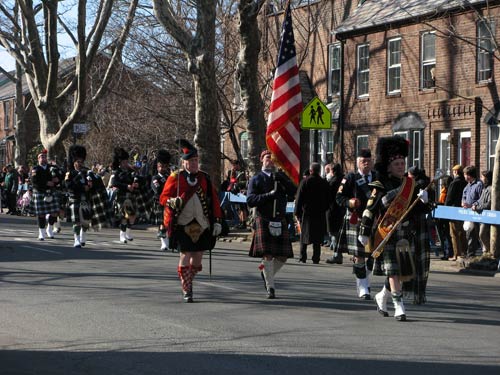
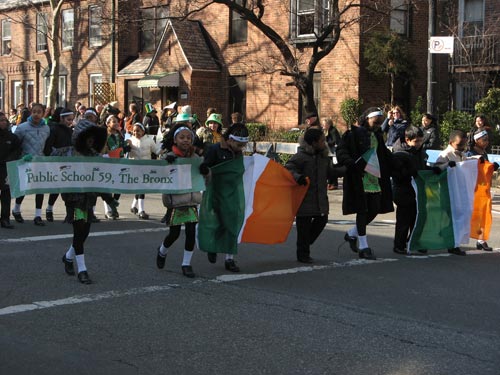
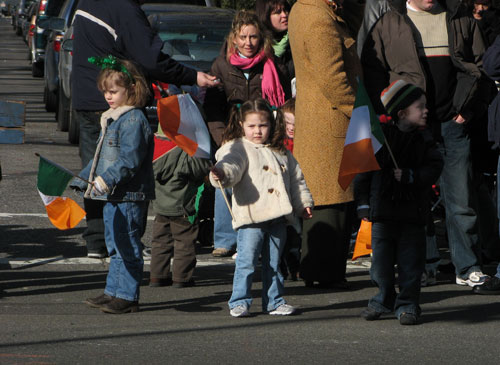
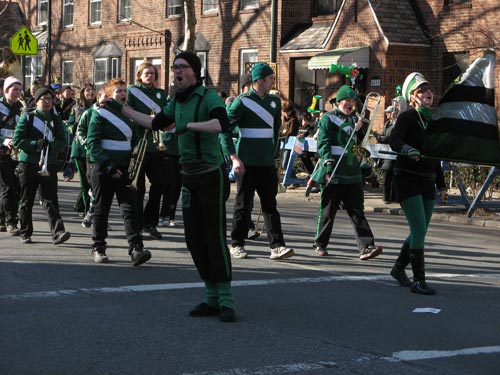
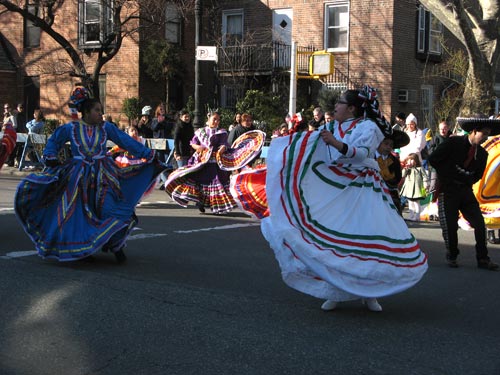
Even canines got to participate, courtesy of S.U.D.S., the Sunnyside United Dog Society:

There was constant music in the air, and I was probably most surprised (and psyched) to hear “Hit Me Baby One More Time” for marching brass band… though in retrospect, I would have saved myself some embarrassment if I’d kept that sentiment to myself. No “Danny Boy“ though.
Check out the full photo set on flickr!
Setagaya at last
At the Public Theater tonight for Unconditional, a new production by Philip Seymour Hoffman and John Ortiz’s LAByrinth Theater Company. The play, written by Brett C. Leonard and directed by 1992’s OBIE Award winner Mark Wing-Davey, is a study in racial tensions and urban isolation, played out in the overlapping stories of nine New Yorkers. Any synopsis of the complicated relationships would best be conveyed by diagram; the play’s natural comparison would be to the 2004 film Crash… another entry in the “everyone hates everyone else” genre. In Unconditional, though, the tensions are mostly confined to between blacks and whites, with one fiery Latina thrown into the mix — probably the most entertaining of the miserable bunch.
The staging was in the round, with scenes played out amidst sliding panels and in every nook and corner of the stage, which made for interesting, if occasionally obstructed views. It all began with a jolting bang (a Confederate flag burning and a hanging) and ended on a somewhat more hopeful note (a wedding). In between there were all kinds of brutality, and quite a bit of sex and swearing. The sprawling cast and rapid-fire series of vignettes made it difficult to invest much emotion into any of the characters’ plights; as a result, the violence and loss did not resonate as intended. What should have been horribly shocking, felt contrived, or worse: gratuitous.
Variety called the play “clever, attention-getting and not very nice”; The New York Times assessed that “the whole adds up to less than the sum of its parts.”

After such depressing fare, we went in for the comfort of ramen noodles. Months ago, we were thwarted in our first attempt to visit much-hyped Ramen Setagaya; this time out, the newness had worn off sufficiently for us to be seated with no wait. (Well, also, it was 10:30PM.)
The narrow glass-enclosed restaurant on First Avenue is the first U.S. location of a popular Japanese ramen chain — just part of a larger Ramenaissance afoot in the city. (See also: newly-opened Ippudo.)

To start, vegetable gyoza. Store bought (beware!), but nicely pan crusted:

Setagaya’s signature ramen is the shio, or salt, ramen. I found the noodles pleasingly firm (there is a row of cooking timers on the kitchen wall to ensure this) and the toppings fresh — grilled-to-order pork slices (which I removed), seaweed, marinated bamboo shoots, julienned green onion, and half a soft-boiled egg, which had just the right custardy consistency. The super-authentic broth is “10 percent meat and 90 percent ingredients such as dried anchovies, clams, scallops, mushrooms, ginger, garlic, and (the secret weapon) Vietnamese salt, all boiled for five to six hours every morning.” It was light, with a complex, distinct seafood flavor which I rather enjoyed; those like my friend who prefer a heartier broth may be better served at Minca. (For what it’s worth, New York magazine likes Setagaya’s ramen the best.)

Oh, and on the way home, I met my first ever Academy Award winning director — riding the 2 at midnight with his son and Academy Award winning wife, no less. Stars… they’re just like us!
Search
Popular Tags
Categories
Archive
- July 2010
- July 2009
- January 2009
- November 2008
- September 2008
- August 2008
- July 2008
- June 2008
- May 2008
- April 2008
- March 2008
- February 2008
- January 2008
- December 2007
- November 2007
- October 2007
- September 2007
- August 2007
- July 2007
- June 2007
- May 2007
- April 2007
- March 2007
- February 2007
- January 2007
- December 2006
- November 2006
- October 2006
- September 2006
- August 2006
- July 2006
- June 2006